Report on Management Functions, Structure, and Interrelations
VerifiedAdded on 2023/01/03
|8
|1967
|73
Report
AI Summary
This report provides a comprehensive overview of management principles, organizational structures, and business functions. It begins by defining management and its core functions, including planning, organizing, commanding, coordinating, and controlling, as introduced by Henry Fayol. The report then delves into different organizational structures such as functional, divisional, and matrix structures, highlighting their advantages and disadvantages. Key business functions like marketing, operations, finance, and human resources are examined, with a focus on the marketing function's relationship with other departments. The report also explores HR and talent management, emphasizing the importance of attracting, training, and motivating employees. Furthermore, it discusses organizational culture, its various types, and its impact on business performance. The report concludes by emphasizing the interrelation of management functions and their collective contribution to achieving organizational goals.
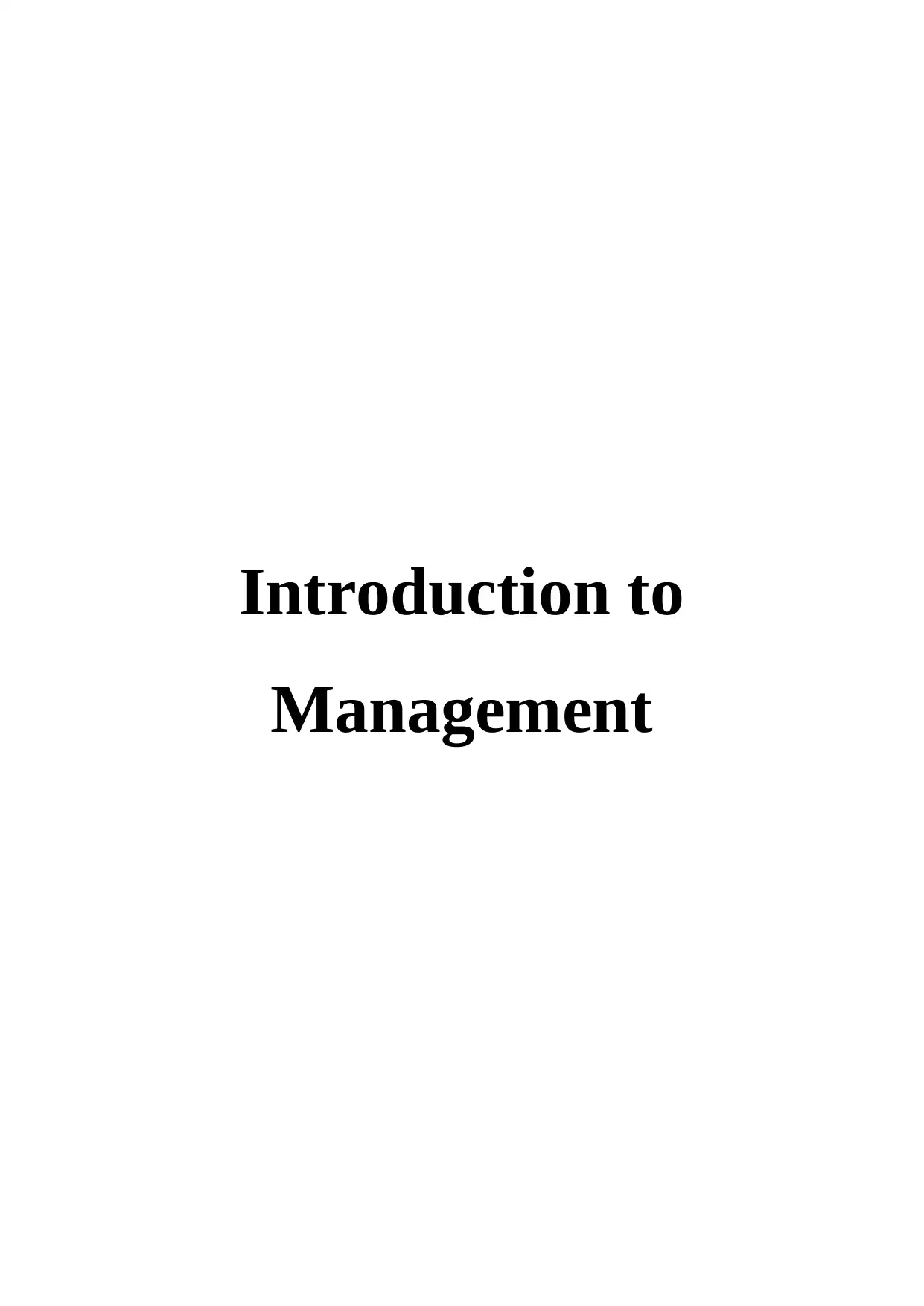
Introduction to
Management
Management
Paraphrase This Document
Need a fresh take? Get an instant paraphrase of this document with our AI Paraphraser
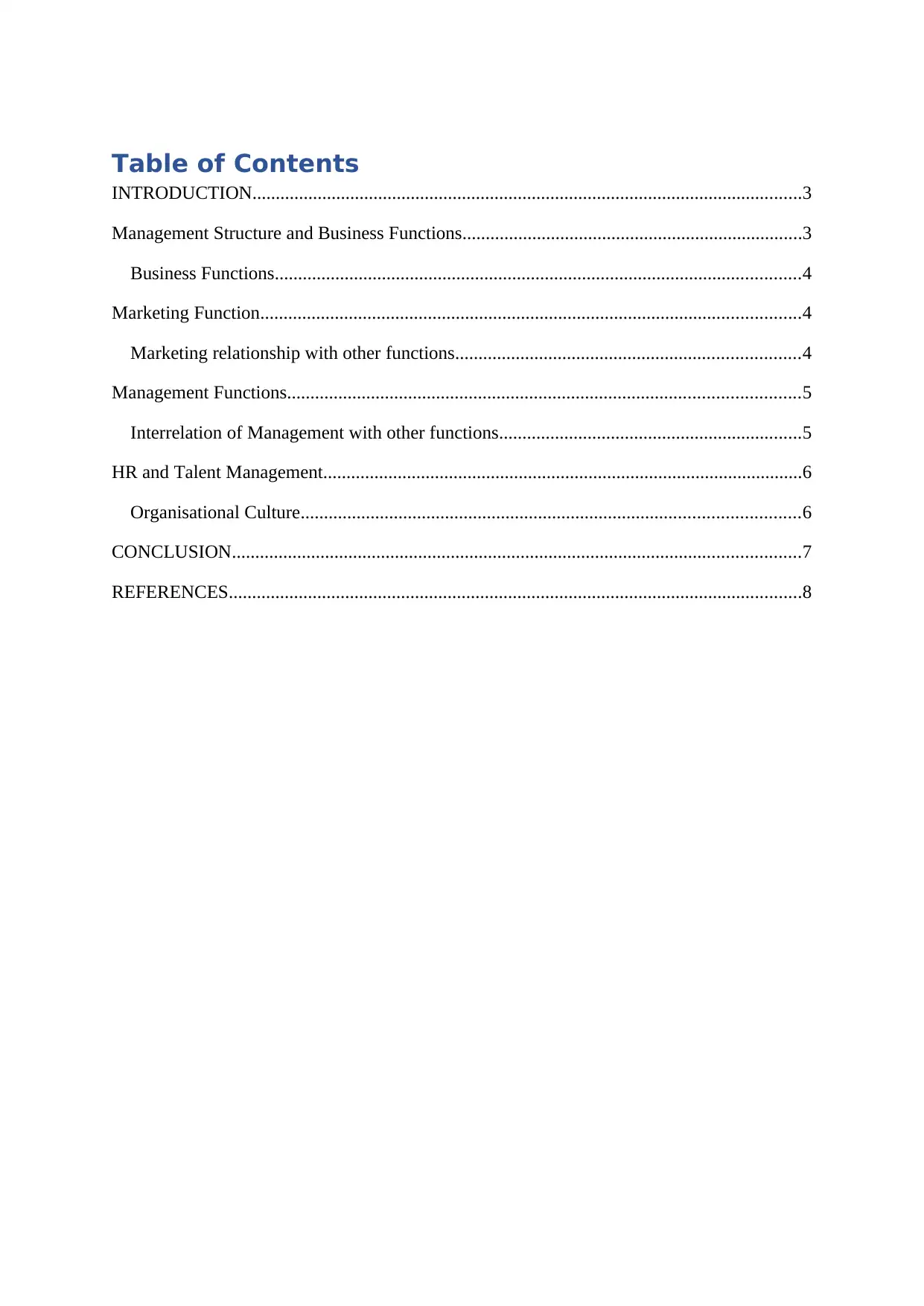
Table of Contents
INTRODUCTION......................................................................................................................3
Management Structure and Business Functions.........................................................................3
Business Functions.................................................................................................................4
Marketing Function....................................................................................................................4
Marketing relationship with other functions..........................................................................4
Management Functions..............................................................................................................5
Interrelation of Management with other functions.................................................................5
HR and Talent Management.......................................................................................................6
Organisational Culture...........................................................................................................6
CONCLUSION..........................................................................................................................7
REFERENCES...........................................................................................................................8
INTRODUCTION......................................................................................................................3
Management Structure and Business Functions.........................................................................3
Business Functions.................................................................................................................4
Marketing Function....................................................................................................................4
Marketing relationship with other functions..........................................................................4
Management Functions..............................................................................................................5
Interrelation of Management with other functions.................................................................5
HR and Talent Management.......................................................................................................6
Organisational Culture...........................................................................................................6
CONCLUSION..........................................................................................................................7
REFERENCES...........................................................................................................................8
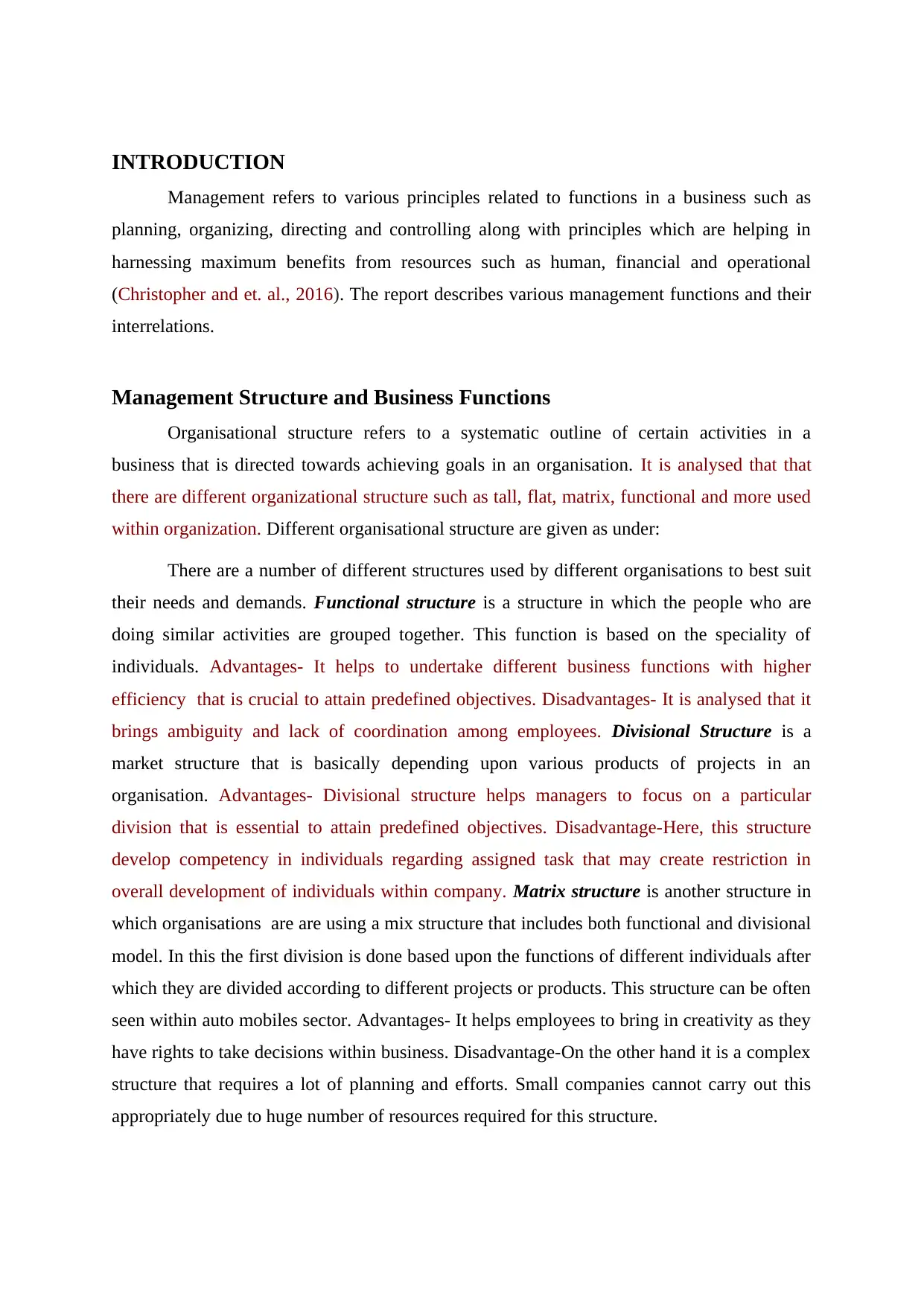
INTRODUCTION
Management refers to various principles related to functions in a business such as
planning, organizing, directing and controlling along with principles which are helping in
harnessing maximum benefits from resources such as human, financial and operational
(Christopher and et. al., 2016). The report describes various management functions and their
interrelations.
Management Structure and Business Functions
Organisational structure refers to a systematic outline of certain activities in a
business that is directed towards achieving goals in an organisation. It is analysed that that
there are different organizational structure such as tall, flat, matrix, functional and more used
within organization. Different organisational structure are given as under:
There are a number of different structures used by different organisations to best suit
their needs and demands. Functional structure is a structure in which the people who are
doing similar activities are grouped together. This function is based on the speciality of
individuals. Advantages- It helps to undertake different business functions with higher
efficiency that is crucial to attain predefined objectives. Disadvantages- It is analysed that it
brings ambiguity and lack of coordination among employees. Divisional Structure is a
market structure that is basically depending upon various products of projects in an
organisation. Advantages- Divisional structure helps managers to focus on a particular
division that is essential to attain predefined objectives. Disadvantage-Here, this structure
develop competency in individuals regarding assigned task that may create restriction in
overall development of individuals within company. Matrix structure is another structure in
which organisations are are using a mix structure that includes both functional and divisional
model. In this the first division is done based upon the functions of different individuals after
which they are divided according to different projects or products. This structure can be often
seen within auto mobiles sector. Advantages- It helps employees to bring in creativity as they
have rights to take decisions within business. Disadvantage-On the other hand it is a complex
structure that requires a lot of planning and efforts. Small companies cannot carry out this
appropriately due to huge number of resources required for this structure.
Management refers to various principles related to functions in a business such as
planning, organizing, directing and controlling along with principles which are helping in
harnessing maximum benefits from resources such as human, financial and operational
(Christopher and et. al., 2016). The report describes various management functions and their
interrelations.
Management Structure and Business Functions
Organisational structure refers to a systematic outline of certain activities in a
business that is directed towards achieving goals in an organisation. It is analysed that that
there are different organizational structure such as tall, flat, matrix, functional and more used
within organization. Different organisational structure are given as under:
There are a number of different structures used by different organisations to best suit
their needs and demands. Functional structure is a structure in which the people who are
doing similar activities are grouped together. This function is based on the speciality of
individuals. Advantages- It helps to undertake different business functions with higher
efficiency that is crucial to attain predefined objectives. Disadvantages- It is analysed that it
brings ambiguity and lack of coordination among employees. Divisional Structure is a
market structure that is basically depending upon various products of projects in an
organisation. Advantages- Divisional structure helps managers to focus on a particular
division that is essential to attain predefined objectives. Disadvantage-Here, this structure
develop competency in individuals regarding assigned task that may create restriction in
overall development of individuals within company. Matrix structure is another structure in
which organisations are are using a mix structure that includes both functional and divisional
model. In this the first division is done based upon the functions of different individuals after
which they are divided according to different projects or products. This structure can be often
seen within auto mobiles sector. Advantages- It helps employees to bring in creativity as they
have rights to take decisions within business. Disadvantage-On the other hand it is a complex
structure that requires a lot of planning and efforts. Small companies cannot carry out this
appropriately due to huge number of resources required for this structure.
⊘ This is a preview!⊘
Do you want full access?
Subscribe today to unlock all pages.

Trusted by 1+ million students worldwide
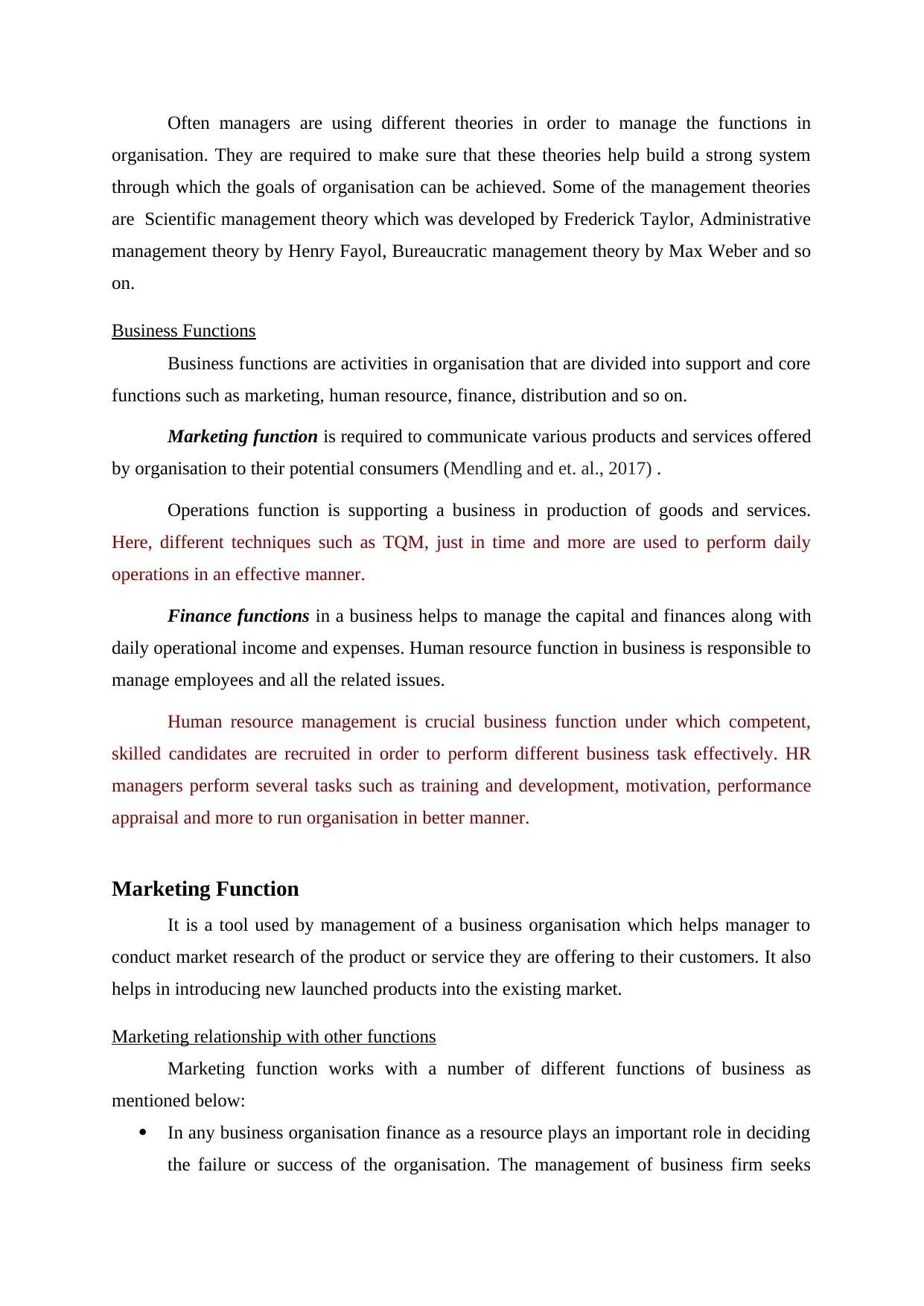
Often managers are using different theories in order to manage the functions in
organisation. They are required to make sure that these theories help build a strong system
through which the goals of organisation can be achieved. Some of the management theories
are Scientific management theory which was developed by Frederick Taylor, Administrative
management theory by Henry Fayol, Bureaucratic management theory by Max Weber and so
on.
Business Functions
Business functions are activities in organisation that are divided into support and core
functions such as marketing, human resource, finance, distribution and so on.
Marketing function is required to communicate various products and services offered
by organisation to their potential consumers (Mendling and et. al., 2017) .
Operations function is supporting a business in production of goods and services.
Here, different techniques such as TQM, just in time and more are used to perform daily
operations in an effective manner.
Finance functions in a business helps to manage the capital and finances along with
daily operational income and expenses. Human resource function in business is responsible to
manage employees and all the related issues.
Human resource management is crucial business function under which competent,
skilled candidates are recruited in order to perform different business task effectively. HR
managers perform several tasks such as training and development, motivation, performance
appraisal and more to run organisation in better manner.
Marketing Function
It is a tool used by management of a business organisation which helps manager to
conduct market research of the product or service they are offering to their customers. It also
helps in introducing new launched products into the existing market.
Marketing relationship with other functions
Marketing function works with a number of different functions of business as
mentioned below:
In any business organisation finance as a resource plays an important role in deciding
the failure or success of the organisation. The management of business firm seeks
organisation. They are required to make sure that these theories help build a strong system
through which the goals of organisation can be achieved. Some of the management theories
are Scientific management theory which was developed by Frederick Taylor, Administrative
management theory by Henry Fayol, Bureaucratic management theory by Max Weber and so
on.
Business Functions
Business functions are activities in organisation that are divided into support and core
functions such as marketing, human resource, finance, distribution and so on.
Marketing function is required to communicate various products and services offered
by organisation to their potential consumers (Mendling and et. al., 2017) .
Operations function is supporting a business in production of goods and services.
Here, different techniques such as TQM, just in time and more are used to perform daily
operations in an effective manner.
Finance functions in a business helps to manage the capital and finances along with
daily operational income and expenses. Human resource function in business is responsible to
manage employees and all the related issues.
Human resource management is crucial business function under which competent,
skilled candidates are recruited in order to perform different business task effectively. HR
managers perform several tasks such as training and development, motivation, performance
appraisal and more to run organisation in better manner.
Marketing Function
It is a tool used by management of a business organisation which helps manager to
conduct market research of the product or service they are offering to their customers. It also
helps in introducing new launched products into the existing market.
Marketing relationship with other functions
Marketing function works with a number of different functions of business as
mentioned below:
In any business organisation finance as a resource plays an important role in deciding
the failure or success of the organisation. The management of business firm seeks
Paraphrase This Document
Need a fresh take? Get an instant paraphrase of this document with our AI Paraphraser
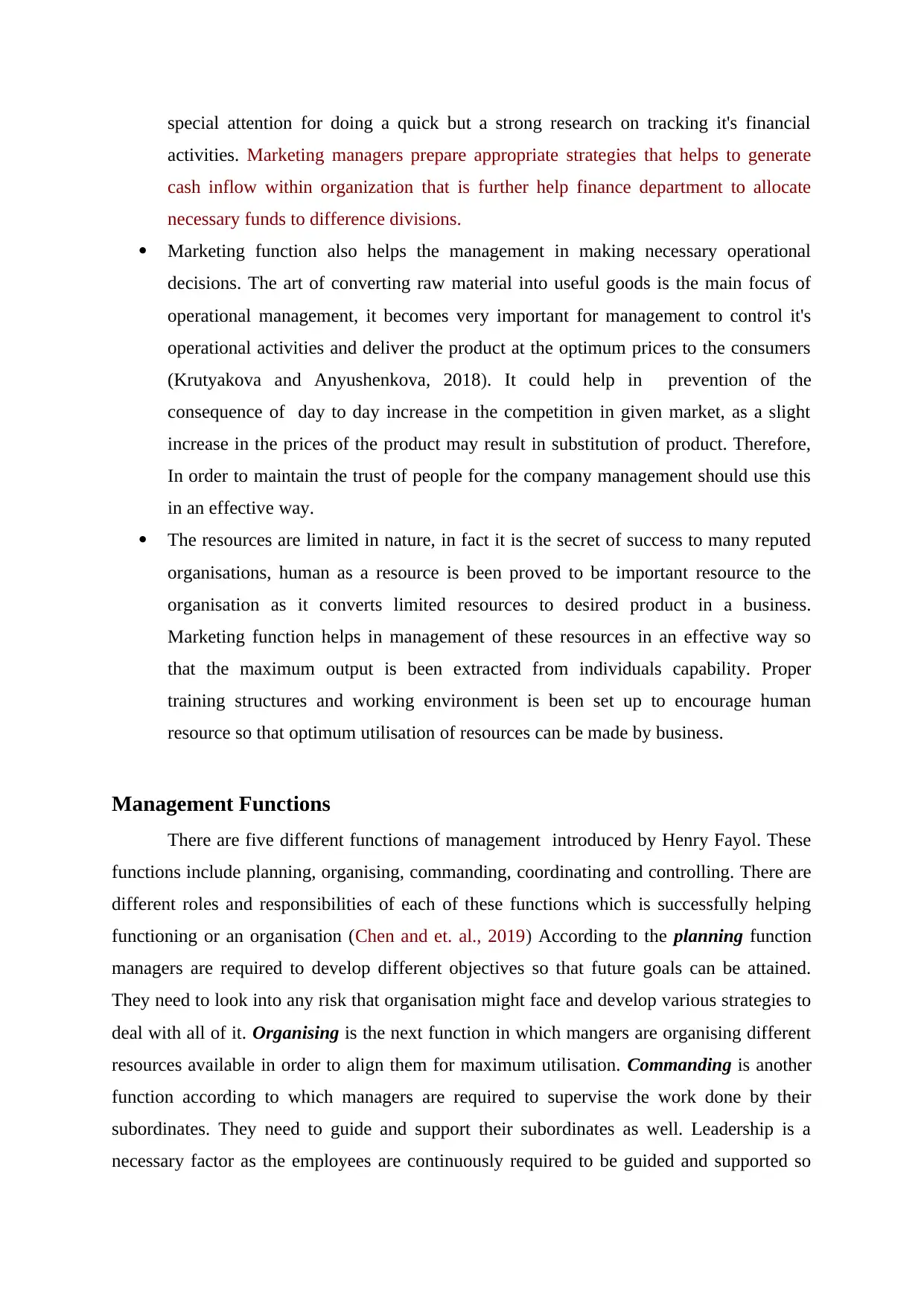
special attention for doing a quick but a strong research on tracking it's financial
activities. Marketing managers prepare appropriate strategies that helps to generate
cash inflow within organization that is further help finance department to allocate
necessary funds to difference divisions.
Marketing function also helps the management in making necessary operational
decisions. The art of converting raw material into useful goods is the main focus of
operational management, it becomes very important for management to control it's
operational activities and deliver the product at the optimum prices to the consumers
(Krutyakova and Anyushenkova, 2018). It could help in prevention of the
consequence of day to day increase in the competition in given market, as a slight
increase in the prices of the product may result in substitution of product. Therefore,
In order to maintain the trust of people for the company management should use this
in an effective way.
The resources are limited in nature, in fact it is the secret of success to many reputed
organisations, human as a resource is been proved to be important resource to the
organisation as it converts limited resources to desired product in a business.
Marketing function helps in management of these resources in an effective way so
that the maximum output is been extracted from individuals capability. Proper
training structures and working environment is been set up to encourage human
resource so that optimum utilisation of resources can be made by business.
Management Functions
There are five different functions of management introduced by Henry Fayol. These
functions include planning, organising, commanding, coordinating and controlling. There are
different roles and responsibilities of each of these functions which is successfully helping
functioning or an organisation (Chen and et. al., 2019) According to the planning function
managers are required to develop different objectives so that future goals can be attained.
They need to look into any risk that organisation might face and develop various strategies to
deal with all of it. Organising is the next function in which mangers are organising different
resources available in order to align them for maximum utilisation. Commanding is another
function according to which managers are required to supervise the work done by their
subordinates. They need to guide and support their subordinates as well. Leadership is a
necessary factor as the employees are continuously required to be guided and supported so
activities. Marketing managers prepare appropriate strategies that helps to generate
cash inflow within organization that is further help finance department to allocate
necessary funds to difference divisions.
Marketing function also helps the management in making necessary operational
decisions. The art of converting raw material into useful goods is the main focus of
operational management, it becomes very important for management to control it's
operational activities and deliver the product at the optimum prices to the consumers
(Krutyakova and Anyushenkova, 2018). It could help in prevention of the
consequence of day to day increase in the competition in given market, as a slight
increase in the prices of the product may result in substitution of product. Therefore,
In order to maintain the trust of people for the company management should use this
in an effective way.
The resources are limited in nature, in fact it is the secret of success to many reputed
organisations, human as a resource is been proved to be important resource to the
organisation as it converts limited resources to desired product in a business.
Marketing function helps in management of these resources in an effective way so
that the maximum output is been extracted from individuals capability. Proper
training structures and working environment is been set up to encourage human
resource so that optimum utilisation of resources can be made by business.
Management Functions
There are five different functions of management introduced by Henry Fayol. These
functions include planning, organising, commanding, coordinating and controlling. There are
different roles and responsibilities of each of these functions which is successfully helping
functioning or an organisation (Chen and et. al., 2019) According to the planning function
managers are required to develop different objectives so that future goals can be attained.
They need to look into any risk that organisation might face and develop various strategies to
deal with all of it. Organising is the next function in which mangers are organising different
resources available in order to align them for maximum utilisation. Commanding is another
function according to which managers are required to supervise the work done by their
subordinates. They need to guide and support their subordinates as well. Leadership is a
necessary factor as the employees are continuously required to be guided and supported so
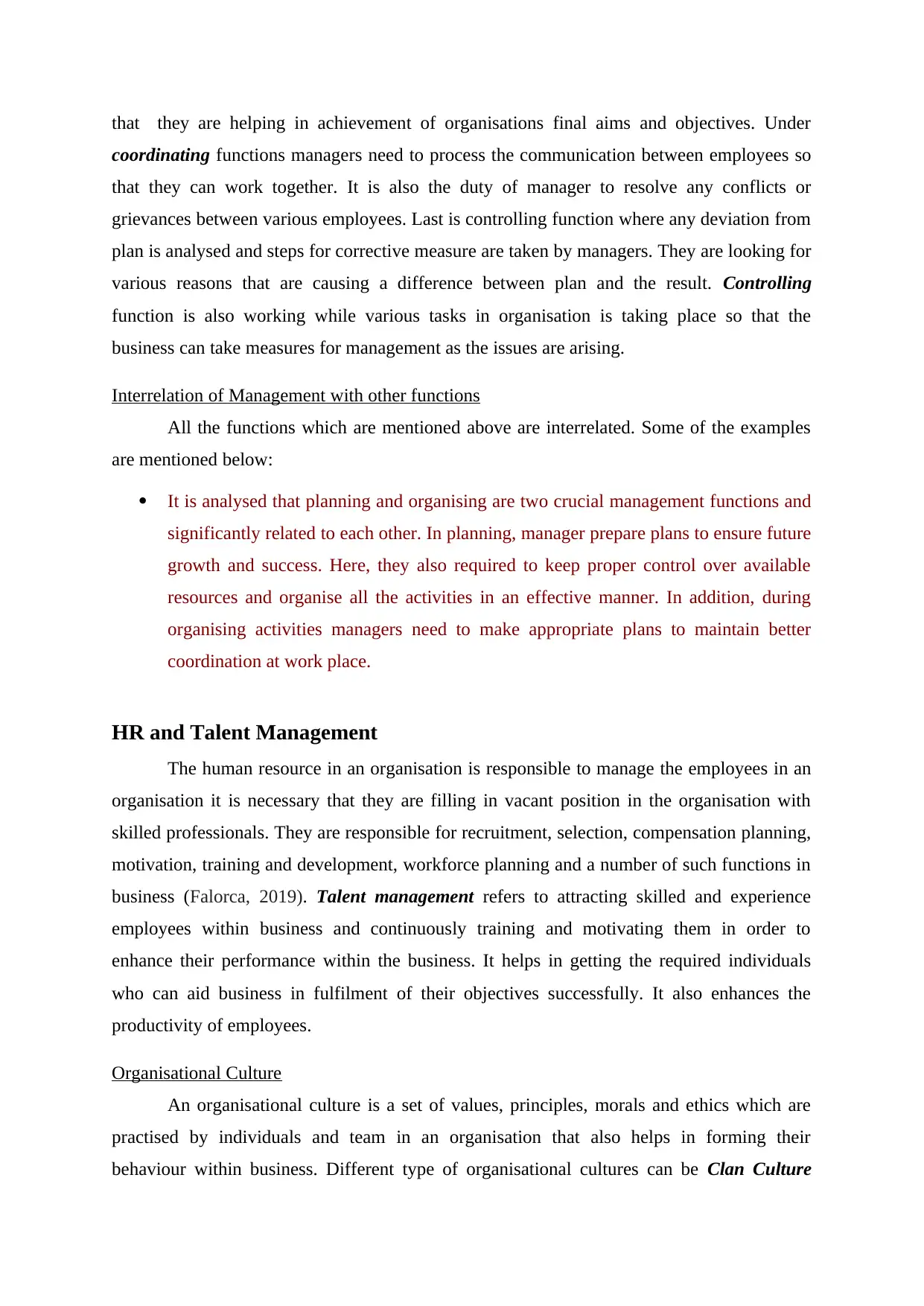
that they are helping in achievement of organisations final aims and objectives. Under
coordinating functions managers need to process the communication between employees so
that they can work together. It is also the duty of manager to resolve any conflicts or
grievances between various employees. Last is controlling function where any deviation from
plan is analysed and steps for corrective measure are taken by managers. They are looking for
various reasons that are causing a difference between plan and the result. Controlling
function is also working while various tasks in organisation is taking place so that the
business can take measures for management as the issues are arising.
Interrelation of Management with other functions
All the functions which are mentioned above are interrelated. Some of the examples
are mentioned below:
It is analysed that planning and organising are two crucial management functions and
significantly related to each other. In planning, manager prepare plans to ensure future
growth and success. Here, they also required to keep proper control over available
resources and organise all the activities in an effective manner. In addition, during
organising activities managers need to make appropriate plans to maintain better
coordination at work place.
HR and Talent Management
The human resource in an organisation is responsible to manage the employees in an
organisation it is necessary that they are filling in vacant position in the organisation with
skilled professionals. They are responsible for recruitment, selection, compensation planning,
motivation, training and development, workforce planning and a number of such functions in
business (Falorca, 2019). Talent management refers to attracting skilled and experience
employees within business and continuously training and motivating them in order to
enhance their performance within the business. It helps in getting the required individuals
who can aid business in fulfilment of their objectives successfully. It also enhances the
productivity of employees.
Organisational Culture
An organisational culture is a set of values, principles, morals and ethics which are
practised by individuals and team in an organisation that also helps in forming their
behaviour within business. Different type of organisational cultures can be Clan Culture
coordinating functions managers need to process the communication between employees so
that they can work together. It is also the duty of manager to resolve any conflicts or
grievances between various employees. Last is controlling function where any deviation from
plan is analysed and steps for corrective measure are taken by managers. They are looking for
various reasons that are causing a difference between plan and the result. Controlling
function is also working while various tasks in organisation is taking place so that the
business can take measures for management as the issues are arising.
Interrelation of Management with other functions
All the functions which are mentioned above are interrelated. Some of the examples
are mentioned below:
It is analysed that planning and organising are two crucial management functions and
significantly related to each other. In planning, manager prepare plans to ensure future
growth and success. Here, they also required to keep proper control over available
resources and organise all the activities in an effective manner. In addition, during
organising activities managers need to make appropriate plans to maintain better
coordination at work place.
HR and Talent Management
The human resource in an organisation is responsible to manage the employees in an
organisation it is necessary that they are filling in vacant position in the organisation with
skilled professionals. They are responsible for recruitment, selection, compensation planning,
motivation, training and development, workforce planning and a number of such functions in
business (Falorca, 2019). Talent management refers to attracting skilled and experience
employees within business and continuously training and motivating them in order to
enhance their performance within the business. It helps in getting the required individuals
who can aid business in fulfilment of their objectives successfully. It also enhances the
productivity of employees.
Organisational Culture
An organisational culture is a set of values, principles, morals and ethics which are
practised by individuals and team in an organisation that also helps in forming their
behaviour within business. Different type of organisational cultures can be Clan Culture
⊘ This is a preview!⊘
Do you want full access?
Subscribe today to unlock all pages.

Trusted by 1+ million students worldwide
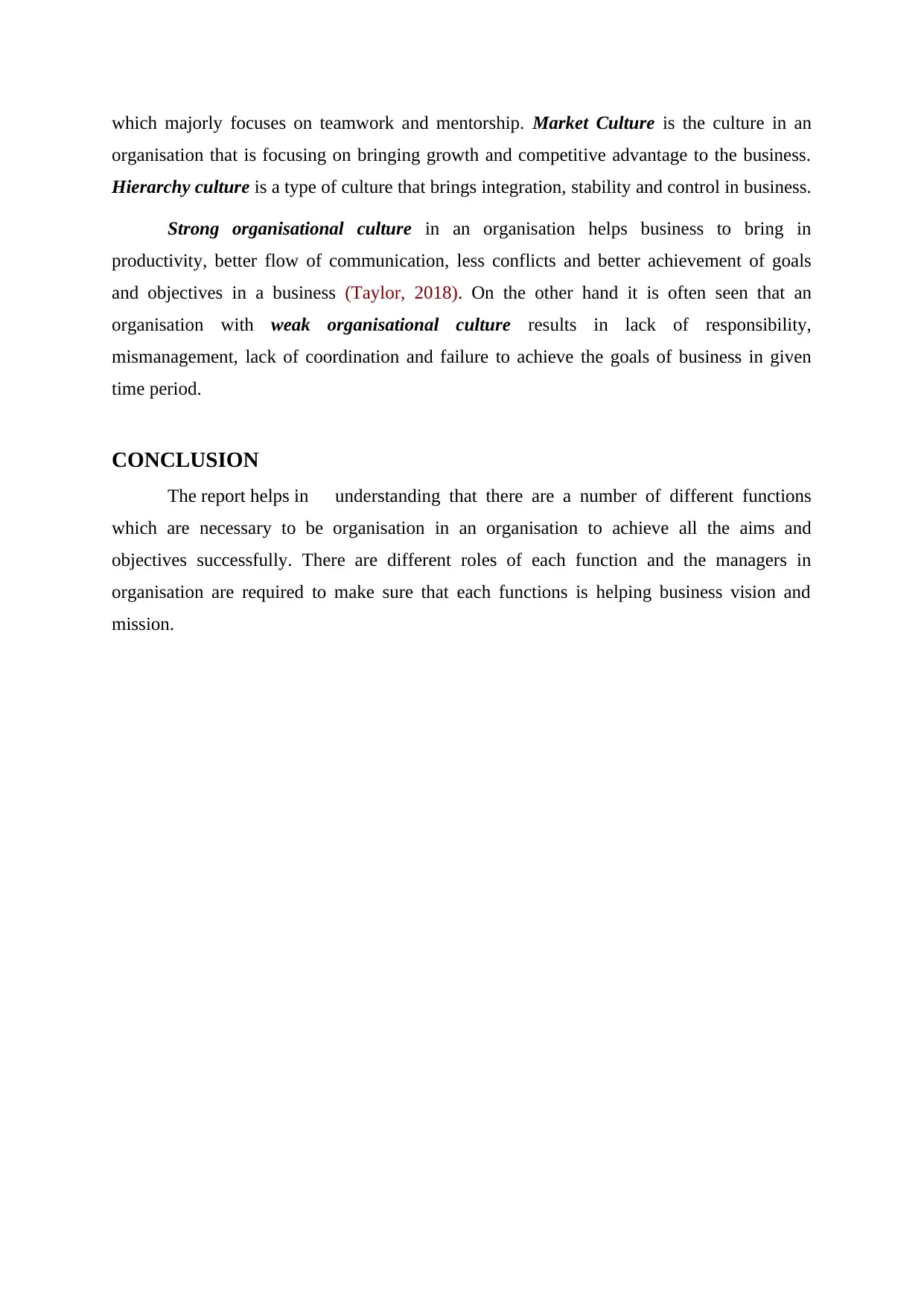
which majorly focuses on teamwork and mentorship. Market Culture is the culture in an
organisation that is focusing on bringing growth and competitive advantage to the business.
Hierarchy culture is a type of culture that brings integration, stability and control in business.
Strong organisational culture in an organisation helps business to bring in
productivity, better flow of communication, less conflicts and better achievement of goals
and objectives in a business (Taylor, 2018). On the other hand it is often seen that an
organisation with weak organisational culture results in lack of responsibility,
mismanagement, lack of coordination and failure to achieve the goals of business in given
time period.
CONCLUSION
The report helps in understanding that there are a number of different functions
which are necessary to be organisation in an organisation to achieve all the aims and
objectives successfully. There are different roles of each function and the managers in
organisation are required to make sure that each functions is helping business vision and
mission.
organisation that is focusing on bringing growth and competitive advantage to the business.
Hierarchy culture is a type of culture that brings integration, stability and control in business.
Strong organisational culture in an organisation helps business to bring in
productivity, better flow of communication, less conflicts and better achievement of goals
and objectives in a business (Taylor, 2018). On the other hand it is often seen that an
organisation with weak organisational culture results in lack of responsibility,
mismanagement, lack of coordination and failure to achieve the goals of business in given
time period.
CONCLUSION
The report helps in understanding that there are a number of different functions
which are necessary to be organisation in an organisation to achieve all the aims and
objectives successfully. There are different roles of each function and the managers in
organisation are required to make sure that each functions is helping business vision and
mission.
Paraphrase This Document
Need a fresh take? Get an instant paraphrase of this document with our AI Paraphraser
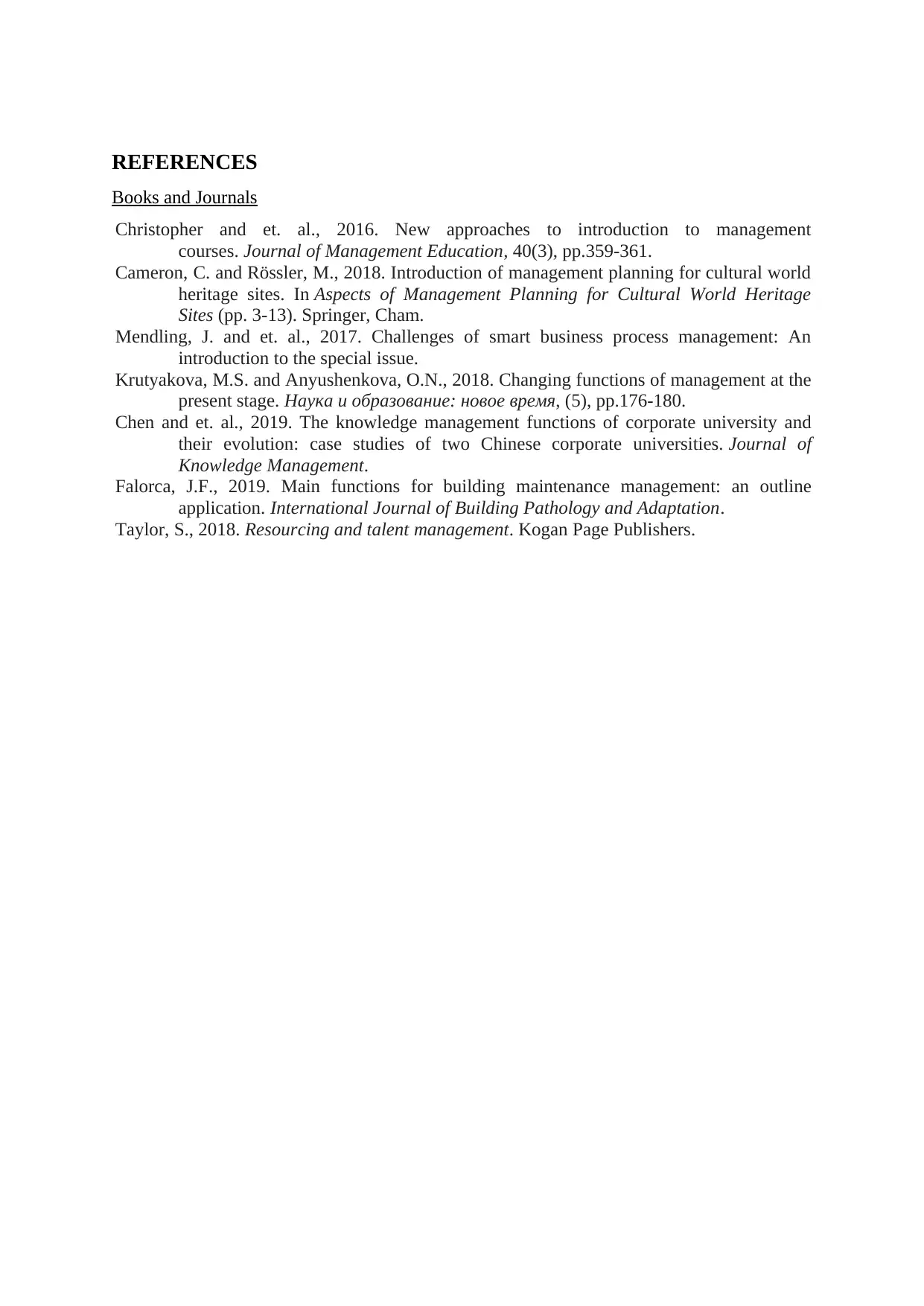
REFERENCES
Books and Journals
Christopher and et. al., 2016. New approaches to introduction to management
courses. Journal of Management Education, 40(3), pp.359-361.
Cameron, C. and Rössler, M., 2018. Introduction of management planning for cultural world
heritage sites. In Aspects of Management Planning for Cultural World Heritage
Sites (pp. 3-13). Springer, Cham.
Mendling, J. and et. al., 2017. Challenges of smart business process management: An
introduction to the special issue.
Krutyakova, M.S. and Anyushenkova, O.N., 2018. Changing functions of management at the
present stage. Наука и образование: новое время, (5), pp.176-180.
Chen and et. al., 2019. The knowledge management functions of corporate university and
their evolution: case studies of two Chinese corporate universities. Journal of
Knowledge Management.
Falorca, J.F., 2019. Main functions for building maintenance management: an outline
application. International Journal of Building Pathology and Adaptation.
Taylor, S., 2018. Resourcing and talent management. Kogan Page Publishers.
Books and Journals
Christopher and et. al., 2016. New approaches to introduction to management
courses. Journal of Management Education, 40(3), pp.359-361.
Cameron, C. and Rössler, M., 2018. Introduction of management planning for cultural world
heritage sites. In Aspects of Management Planning for Cultural World Heritage
Sites (pp. 3-13). Springer, Cham.
Mendling, J. and et. al., 2017. Challenges of smart business process management: An
introduction to the special issue.
Krutyakova, M.S. and Anyushenkova, O.N., 2018. Changing functions of management at the
present stage. Наука и образование: новое время, (5), pp.176-180.
Chen and et. al., 2019. The knowledge management functions of corporate university and
their evolution: case studies of two Chinese corporate universities. Journal of
Knowledge Management.
Falorca, J.F., 2019. Main functions for building maintenance management: an outline
application. International Journal of Building Pathology and Adaptation.
Taylor, S., 2018. Resourcing and talent management. Kogan Page Publishers.
1 out of 8
Related Documents
Your All-in-One AI-Powered Toolkit for Academic Success.
+13062052269
info@desklib.com
Available 24*7 on WhatsApp / Email
![[object Object]](/_next/static/media/star-bottom.7253800d.svg)
Unlock your academic potential
Copyright © 2020–2025 A2Z Services. All Rights Reserved. Developed and managed by ZUCOL.




